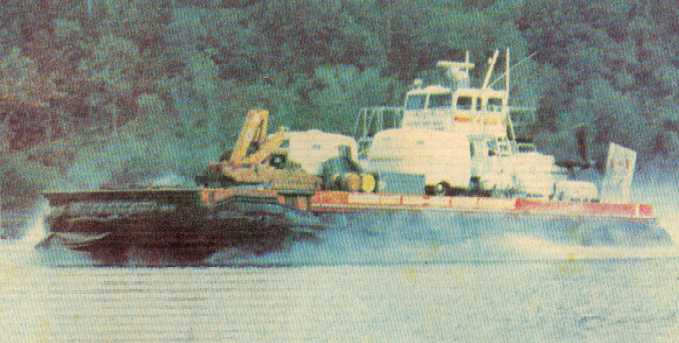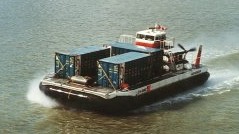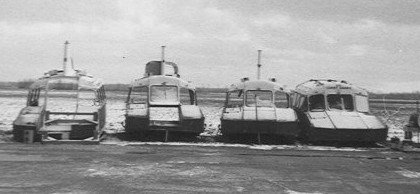Bell Aerospace Canada
Voyageur

The CCG Voyageur, based in Montreal, once visited Ottawa
on buoy tending duties. It completed what was once a several day task in
just one day! The above photo was taken from the front page of Ottawa
Citizen, Aug 4th, 1979. Voyageur was powered by two UAC ST6T-75 Twin-Pac marine
gas turbines of 1,300 SHP continuous power per unit. These drove two
Hamilton Standard 9' diameter 3-blade variable pitch propellers and two 7'
diameter centrifugal lift fans via gearbox. The cargo deck was 40-feet
long and 33-feet wide.

The world's first airborne landing pad as tested by the CCG and
Northern Transportation company. This was the first time a helicopter
successfully landed on a hovercraft. This was part of the Voyageur
trials on Lake Ontario.


The photo on the left shows Voyagers load carrying capabilities.
The photo on the right of four SK5 skeletons was taken on the ramp in Grand Bend, Ontario.
Although Bell Aerosystems denied that it happened, the first two
Voyageurs were assembled from scavenged Bell SK-5's.
The US Navy was so impressed with the Voyageur
that a huge order was placed for their developed version known as the
LACV-30. Unfortunately, this saw the withdrawal of Bell Aerospace in
Canada as they moved their facilities virtually overnight to New Orleans.
This was done in spite of heavy investment by the Canadian Government to develop
the Voyageur program. The LACV-30 US Navy program has now been discontinued and the
entire fleet of over 60 vehicles was handed over to a native band in Alaska as
part of a treaty program.
Recently obtained info from a former field rep for the US. Army
suggests that in fact it was the US Army that first obtained hovercraft from
Bell Areospace. The Army had the US Navy do tests on LACV 01 and LACV 02,
believed to have been constructed from scavenged parts from the Voyager
program. The Army only purchased 26 total of these vessels. They were then
turned in to the Defense Dept. Reutilization Program to be sold in an effort
recoup millions spent on the project. Before the craft were sold a qualified organization
(native band in Alaska) expressed an interest in obtaining the craft free
from the government. They had no knowledge of Hovercraft especially this size
but they just happened to have a company on site to help them. The companies
name was Textron marine formally Bell Aerospace Canada. The US NAVY went on to
purchase aprox. 76 or more LCACs from Textron Marine. The US Army currently
has no Hovercraft that the source is aware of. He reports seeing some of the
craft stacked on top of each other rusting away under the 1st Street bridge in
Seattle.
Particulars:
Length: 65.7' Width: 36.7'
Height 22' Emp. Wt: 37,700 lb Payload:
52,300 lb Max Speed: 55 mph
The Voyageur was manufactured by
Bell Aerospace Canada
P.O. Box 160
Grand Bend, Ontario
Tel: (519) 238-2333
|
